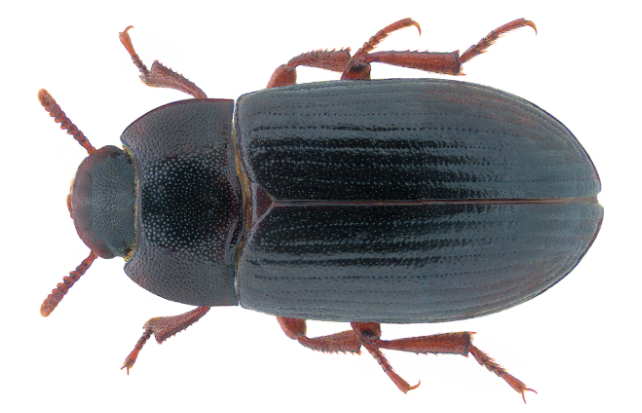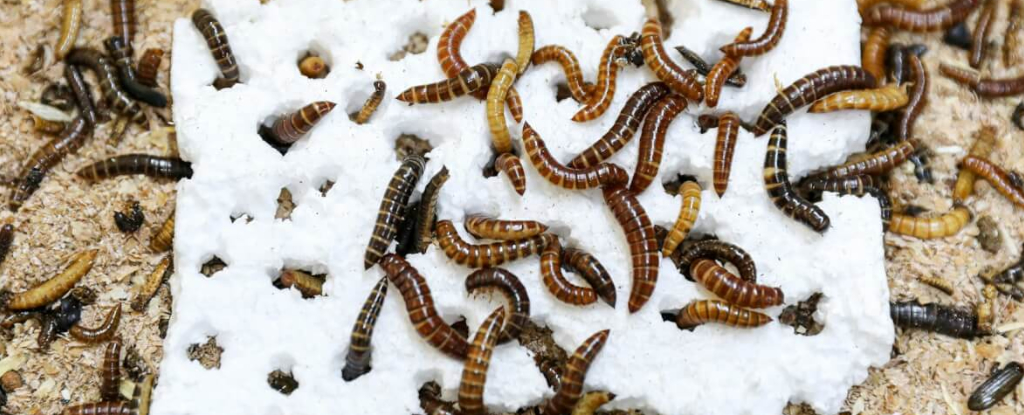Products You May Like
There’s been an exciting new discovery in the fight against plastic pollution: mealworm larvae that are capable of consuming polystyrene.
They join the ranks of a small group of insects that have been found to be capable of breaking the polluting plastic down, though this is the first time that an insect species native to Africa has been found to do this.
Polystyrene, commonly known as styrofoam, is a plastic material that’s widely used in food, electronic and industrial packaging. It’s difficult to break down and therefore durable. Traditional recycling methods – like chemical and thermal processing – are expensive and can create pollutants. This was one of the reasons we wanted to explore biological methods of managing this persistent waste.
I am part of a team of scientists from the International Centre of Insect Physiology and Ecology who have found that the larvae of the Kenyan lesser mealworm can chew through polystyrene and host bacteria in their guts that help break down the material.
The lesser mealworm is the larval form of the Alphitobius darkling beetle. The larval period lasts between 8 and 10 weeks. The lesser mealworm are mostly found in poultry rearing houses which are warm and can offer a constant food supply – ideal conditions for them to grow and reproduce.
Though lesser mealworms are thought to have originated in Africa, they can be found in many countries around the world. The species we identified in our study, however, could be a sub-species of the Alphitobius genus. We are conducting further investigation to confirm this possibility.

Our study also examined the insect’s gut bacteria. We wanted to identify the bacterial communities that may support the plastic degradation process.
Plastic pollution levels are at critically high levels in some African countries. Though plastic waste is a major environmental issue globally, Africa faces a particular challenge due to high importation of plastic products, low re-use and a lack of recycling of these products.
By studying these natural “plastic-eaters”, we hope to create new tools that help get rid of plastic waste faster and more efficiently. Instead of releasing a huge number of these insects into trash sites (which isn’t practical), we can use the microbes and enzymes they produce in factories, landfills and cleanup sites. This means plastic waste can be tackled in a way that’s easier to manage at a large scale.
Key findings
We carried out a trial, lasting over a month. The larvae were fed either polystyrene alone, bran (a nutrient-dense food) alone, or a combination of polystyrene and bran.
We found that mealworms on the polystyrene-bran diet survived at higher rates than those fed on polystyrene alone. We also found that they consumed polystyrene more efficiently than those on a polystyrene-only diet. This highlights the benefits of ensuring the insects still had a nutrient-dense diet.
While the polystyrene-only diet did support the mealworms’ survival, they didn’t have enough nutrition to make them efficient in breaking down polystyrene. This finding reinforced the importance of a balanced diet for the insects to optimally consume and degrade plastic. The insects could be eating the polystyrene because it’s mostly made up of carbon and hydrogen, which may provide them an energy source.
The mealworms on the polystyrene-bran diet were able to break down approximately 11.7 percent of the total polystyrene over the trial period.
Gut bacteria
The analysis of the mealworm gut revealed significant shifts in the bacterial composition depending on the diet. Understanding these shifts in bacterial composition is crucial because it reveals which microbes are actively involved in breaking down plastic. This will help us to isolate the specific bacteria and enzymes that can be harnessed for plastic degradation efforts.
The guts of polystyrene-fed larvae were found to contain higher levels of Proteobacteria and Firmicutes, bacteria that can adapt to various environments and break down a wide range of complex substances.
Bacteria such as Kluyvera, Lactococcus, Citrobacter and Klebsiella were also particularly abundant and are known to produce enzymes capable of digesting synthetic plastics. The bacteria won’t be harmful to the insect or to the environment when used at scale.
The abundance of bacteria indicates that they play a crucial role in breaking down the plastic. This may mean that mealworms may not naturally have the ability to eat plastic.
Instead, when they start eating plastic, the bacteria in their guts might change to help break it down. Thus, the microbes in the mealworms’ stomachs can adjust to unusual diets, like plastic.
These findings support our hypothesis that the gut of certain insects can enable plastic degradation. This is likely because the bacteria in their gut can produce enzymes that break down plastic polymers.
This raises the possibility of isolating these bacteria, and the enzymes produced, to create microbial solutions that will address plastic waste on a larger scale.
What’s next
Certain insect species, such as yellow mealworms (Tenebrio molitor) and superworms (Zophobas morio), have already demonstrated the ability to consume plastics. They’re able to break down materials like polystyrene with the help of bacteria in their gut.
Our research is unique because it focuses on insect species native to Africa, which have not been extensively studied in the context of plastic degradation.
This regional focus is important because the insects and environmental conditions in Africa may differ from those in other parts of the world, potentially offering new insights and practical solutions for plastic pollution in African settings.
The Kenyan lesser mealworm’s ability to consume polystyrene suggests that it could play a role in natural waste reduction, especially for types of plastic that are resistant to conventional recycling methods.
Future studies could focus on isolating and identifying the specific bacterial strains involved in polystyrene degradation and examining their enzymes.
We hope to figure out if the enzymes can be produced at scale for recycling waste.
Additionally, we may explore other types of plastics to test the versatility of this insect for broader waste management applications.
Scaling up the use of the lesser mealworms for plastic degradation would also require strategies for ensuring insect health over prolonged plastic consumption, as well as evaluating the safety of resulting insect biomass for animal feeds.![]()
Fathiya Khamis, Senior Scientist, International Centre of Insect Physiology and Ecology
This article is republished from The Conversation under a Creative Commons license. Read the original article.
